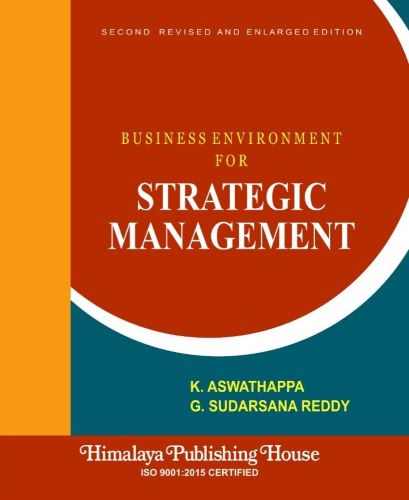The second edition of Business Environment for Strategic Management has been enriched with the following changes :
• The following four new chapters have been added:
Chapter 2 — Business Environment
Chapter 31 — External Sector
Chapter 36 — Business Ethics
Chapter 37 — Corporate Governance
• At the end of each environmental factor is included a section on its analysis and integration in the corporate strategic management.
• Assignment – a new feature is added at the end of each chapter. These assignments, if taken up by the students seriously, will help them bridge the gap between what is being practised in the industry and what is being read in the book.
• The book has become richer with new tables, exhibits and additional inputs to the text.
• The book is rich with pedagogic aids such as chapter outline, learning objectives and review questions. Margin notes in each page is a value add to the book.
Contents –
1. Nature of Business
Scope of Business
Characteristics of Contemporary Business
Business Objectives
Critics of Business
2. Business Environment
Nature of Environment
Analysis of Environment
Benefits of Analysis
Limitations of Analysis
3. Meaning and Rationale for Globalisation
Nature of Globalisation
Drivers of Globalisation
Players in International Business
Challenges of International Business
4. Strategies for Going Global
Strategies in Globalisation
Flow of FDI
5. From Domestic Market to Global Markets
Historical Perspective
Investment Flows
Attracting Foreign Capital
Implications for Indian Industry
Destination India
6 India, WTO and the Trading Blocks
Basic Principles of WTO
Functions of WTO
GATT and WTO
WTO Structure
The Final Act
Implications for India
Trading Blocks
Analysis of Global Environment
7. Technological Environment
Main Features of Technology
Impact of Technology
Management of Technology
Status of Technology in India
Analysis of Technological Environment
8. Political Institutions
Three Political Institutions
Judiciary
Judicial Activism
9. The Constitution of India
The Preamble
The Fundamental Rights
Directive Principles of State Policy
Time for Change
10. Rationale and Extent of State Intervention
Reasons for State Intervention
Types of Intervention
Extent of Intervention
Consequences of Controls
Features of a Good Control System
Government-Business Interface–Historical Evolution
11. End of Government in Business?
Why should the Government Continue its Interventionist Policy?
What Should be the Form of State Intervention?
Analysis of Political Environment
12 Economic Environment
Nature of Economic Environment
Economic Factors
Claims and Counter claims
Agenda for the Future
13. Industrial Policy
Rationale for Industrial Policy
Industrial Policy Resolution, 1948
Industrial Policy, 1956
Industrial Policy, 1991
14. Industrial Licensing
Licensing and its Objectives
Legislative Framework for Licensing
Criticisms of Licensing
15. From the MRTP Act, 1969 to the Competition Act, 2003
Objectives of the MRTP Act
Regulation of Trade Practices
Objectives of the Competition Act
Provisions of the Act
16. From Foreign Exchange Regulation Act, to Foreign Exchange Management Act
Objectives of the Act
Provisions of the Act
Some Reflections on the Act
Do We Need FERA?
Amendments to the Act
From FERA to FEMA
FEMA, 1999
17. The Companies Act, 1956
Evolution of the Company
Meaning and Definition
Classification of Companies
Company Formation
Company Law
Company Law Administration
Observations on the Act
Companies Amendment Bill
18. Public Sector Enterprises
Definition and Objectives
Evolution of the Public Sector
Growth and Role
Performance
What Needs to be Done?
Reforms in Public Sector Enterprises
Bureau of Public Enterprises
Ownership Pattern of PSUs
Industrial Policy Statement 1991 on Public Sector
19. Privatisation
History of Privatisation
Nature and Objectives
Privatisation Routes
Record to Date
Disinvestment in India
Arguments Against Privatisation
Ranga Rajan Committee on Privatisation
Disinvestment Commission
20. Small Scale Industries
Meaning of SSI Units
Growth of SSIs
Significance of SSIs
The Case for SSIs
Facilities
Problems and Remedials
Small Sector Industrial Policy
Recommendations of the Abid Hussain Committee
SIDBI Survey
21. Industrial Labour
Extent of Labour
Changes in Labour Force
Trade Union Movement
Industrial Disputes
Wage Policy
Social Security in India
22. Industrial Sickness
Definition of a Sick Unit
Extent of Sickness
Causes for Sickness
Effect of Sickness
Remedies
Omkar Swami Committee on Sickness
23. Exit Policy
Arguments for Exit Policy
Arguments against Exit Policy
National Renewal Fund
24. Infrastructure
Growth of Infrastructure
Concluding Remarks
25. Development Banks
Operations and Trends
Critical Assessment
Narasimham Committee on FDIs
The Road Ahead
26. Stock Exchanges
Nature of Stock Exchanges
Functions of Stock Markets
Benefits of Share Markets
Growth of Stock Exchanges
Dealings in Share Markets
Organisation of Stock Markets
The Securities Contracts Act
Positive Features
Negative Features
Reforms
27. Monetary and Fiscal Policies
Monetary Policy
Money Market
Fiscal Policy
Union Budget 2006-2007
28. Agriculture
Role of Agriculture
Extent of Farm Output
Problems
Agenda for Action
29. Balanced Regional Development
Criteria for Backwardness
Causes for Backwardness and Regional Imbalances
The Problem
Measures to Remove Regional Imbalances
Failure of Regional Planning
Suggestions to Remove Regional Imbalances
30. Price and Distribution Controls
Objectives of Price and Distribution Controls
Control of Prices
Public Distribution System
The Essential Commodities Act, 1955
31. External Sector
Foreign Trade
Trade-in Services
Balance of Payments
Exchange Rate Management
32. New Economic Policy
Background to the New Policy
The New Policy
The Second Generation Reforms
Analysis of Economic Environment
33. Cultural Environment
Nature of Culture
Impact of Culture on Business
Business Participation in Cultural Affairs
34. Social Responsibility of Business
Nature and Models of Social Responsibility
Arguments for Social Responsibility
Arguments Against Social Responsibility
Barriers to Social Responsibility
Social Responsibility Strategies
Social Responsibility Implementation
Limits of Social Responsibility
Common Characteristics
Evolving Idea of Social Responsibility
Indian Scenario
35. Business and Society
Nature and Models of Social Responsibility
Ecology and Business
Women and Business Opportunities
Child Labour
Consumerism
Rural Development
Projects and People
Physically Handicapped
Fighting AIDS
36. Business Ethics
Nature of Ethics
Sources of Ethics
Why is Ethics Important?
Are Businessmen Ethical?
Ethical Dilemmas
Managing Ethics
Corporate Culture and Ethical Climate
Improving Ethical Decision Making
37. Corporate Governance
Nature of Corporate Governance
The Context
Factors Influencing Corporate Governance
Mechanisms of Corporate Governance
The Future
Government Report
Analysis of Social and Cultural Environment
38. Natural Environment
Nature of Physical Environment
Impact on Business
Analysis of Physical Environment
39. Integrating Environment and Strategic Management
Integration of Segments
Environmental Analysis Forming Part of Strategic Management
Political Strategy







